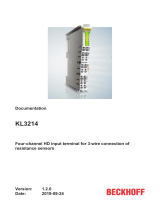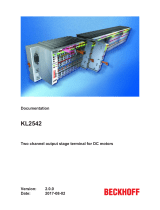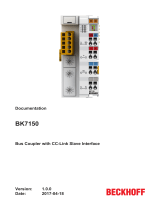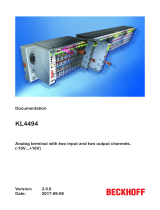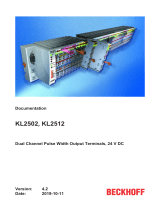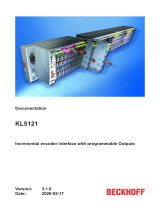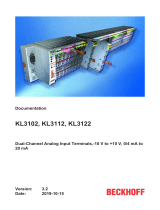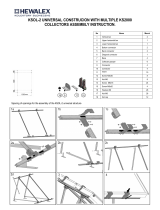Page is loading ...

Documentation
KL2819
HD Bus Terminal, 16-channel digital output 24 V DC, with
diagnostics
1.0.0
2016-12-15
Version:
Date:


Table of contents
KL2819 3Version: 1.0.0
Table of contents
1 Foreword ....................................................................................................................................................4
1.1 Notes on the documentation........................................................................................................... 4
1.2 Safety instructions .......................................................................................................................... 5
1.3 Documentation Issue Status........................................................................................................... 6
1.4 Non-reactive Bus Terminals ........................................................................................................... 6
2 KL2819 - Introduction and technical data ...............................................................................................7
2.1 Introduction and pin assignment..................................................................................................... 7
2.2 Technical data ................................................................................................................................ 9
2.3 Overload protection ........................................................................................................................ 9
3 Mounting and wiring ...............................................................................................................................12
3.1 Installation on mounting rails ........................................................................................................ 12
3.2 Connection system ....................................................................................................................... 14
3.3 Installation positions ..................................................................................................................... 17
3.4 ATEX - Special conditions ............................................................................................................ 19
3.5 ATEX Documentation ................................................................................................................... 20
4 KS2000 Configuration software .............................................................................................................21
4.1 KS2000 - Introduction ................................................................................................................... 21
4.2 Register ........................................................................................................................................ 22
5 Access from the user programm ...........................................................................................................24
5.1 Control and status bytes ............................................................................................................... 24
5.1.1 Process data mode ..........................................................................................................24
5.1.2 Register communication...................................................................................................24
5.2 Register overview ......................................................................................................................... 26
5.3 Register description ...................................................................................................................... 27
6 Appendix ..................................................................................................................................................30
6.1 Support and Service ..................................................................................................................... 30

Foreword
KL28194 Version: 1.0.0
1 Foreword
1.1 Notes on the documentation
Intended audience
This description is only intended for the use of trained specialists in control and automation engineering who
are familiar with the applicable national standards.
It is essential that the documentation and the following notes and explanations are followed when installing
and commissioning these components.
It is the duty of the technical personnel to use the documentation published at the respective time of each
installation and commissioning.
The responsible staff must ensure that the application or use of the products described satisfy all the
requirements for safety, including all the relevant laws, regulations, guidelines and standards.
Disclaimer
The documentation has been prepared with care. The products described are, however, constantly under
development.
We reserve the right to revise and change the documentation at any time and without prior announcement.
No claims for the modification of products that have already been supplied may be made on the basis of the
data, diagrams and descriptions in this documentation.
Trademarks
Beckhoff
®
, TwinCAT
®
, EtherCAT
®
, Safety over EtherCAT
®
, TwinSAFE
®
, XFC
®
and XTS
®
are registered
trademarks of and licensed by Beckhoff Automation GmbH.
Other designations used in this publication may be trademarks whose use by third parties for their own
purposes could violate the rights of the owners.
Patent Pending
The EtherCAT Technology is covered, including but not limited to the following patent applications and
patents: EP1590927, EP1789857, DE102004044764, DE102007017835 with corresponding applications or
registrations in various other countries.
The TwinCAT Technology is covered, including but not limited to the following patent applications and
patents: EP0851348, US6167425 with corresponding applications or registrations in various other countries.
EtherCAT
®
is registered trademark and patented technology, licensed by Beckhoff Automation GmbH,
Germany
Copyright
© Beckhoff Automation GmbH & Co. KG, Germany.
The reproduction, distribution and utilization of this document as well as the communication of its contents to
others without express authorization are prohibited.
Offenders will be held liable for the payment of damages. All rights reserved in the event of the grant of a
patent, utility model or design.

Foreword
KL2819 5Version: 1.0.0
1.2 Safety instructions
Safety regulations
Please note the following safety instructions and explanations!
Product-specific safety instructions can be found on following pages or in the areas mounting, wiring,
commissioning etc.
Exclusion of liability
All the components are supplied in particular hardware and software configurations appropriate for the
application. Modifications to hardware or software configurations other than those described in the
documentation are not permitted, and nullify the liability of Beckhoff Automation GmbH & Co. KG.
Personnel qualification
This description is only intended for trained specialists in control, automation and drive engineering who are
familiar with the applicable national standards.
Description of symbols
In this documentation the following symbols are used with an accompanying safety instruction or note. The
safety instructions must be read carefully and followed without fail!
DANGER
Serious risk of injury!
Failure to follow the safety instructions associated with this symbol directly endangers the
life and health of persons.
WARNING
Risk of injury!
Failure to follow the safety instructions associated with this symbol endangers the life and
health of persons.
CAUTION
Personal injuries!
Failure to follow the safety instructions associated with this symbol can lead to injuries to
persons.
Attention
Damage to the environment or devices
Failure to follow the instructions associated with this symbol can lead to damage to the en-
vironment or equipment.
Note
Tip or pointer
This symbol indicates information that contributes to better understanding.

Foreword
KL28196 Version: 1.0.0
1.3 Documentation Issue Status
Version Comment
1.0.0 • First published
Firmware and hardware versions
Documentation
Version
KL2819
Firmware Hardware
1.0.0 1A 00
The firmware and hardware versions (delivery state) can be taken from the serial number printed on the side
of the terminal.
Syntax of the serial number
Structure of the serial number: WW YY FF HH
WW - week of production (calendar week)
YY - year of production
FF - firmware version
HH - hardware version
Example with ser. no.: 40 15 1A 00:
40 - week of production 40
15 - year of production 2015
1A - firmware version 1A
00 - hardware version 00
1.4 Non-reactive Bus Terminals
Note
Use of non-reactive Bus Terminals in safety applications
If a Bus Terminal is described as non-reactive, this means that the downstream terminal
behaves passively in a safety application (e.g. in the case of the all-pole switch-off of a po-
tential group).
In this case the terminals do not represent an active part of the safety controller and do not
affect the Safety Integrity Level (SIL) or Performance Level (PL) attained in the safety appli-
cation.
For details, please refer to chapter 2.17f in the TwinSAFE application manual.
Attention
Pay attention to the hardware version
Please pay attention to the information about the hardware version and non-reactivity of the
respective Bus Terminal in the chapters "Technical Data" or "Firmware Compatibility"!
Only terminals with the appropriate hardware version may be used without the attained SIL/
PL being affected!

KL2819 - Introduction and technical data
KL2819 7Version: 1.0.0
2 KL2819 - Introduction and technical data
2.1 Introduction and pin assignment
Fig.1: KL2819
HD Bus Terminal, 16-channel digital output 24 V DC, 0.5 A, with diagnostics
The KL2819 Bus Terminal has 16 digital output channels for the switching of 24 V loads up to 0.5 A. The
integrated diagnostics can be evaluated by the controller and indicated by the LEDs. Overtemperature and
the lack of a voltage supply to the terminal are supplied as diagnostic information. Moreover, each of the
channels can signal e.g. a short circuit. The switching state and any error of the output are indicated by the
LED. Maintenance of the application is simplified by the diagnostic function. The power contacts are
connected through; reference ground of the outputs is the 0 V power contact. The outputs are electrically
isolated from the fieldbus side.
KL2819 – LEDs
LED Color Meaning
OUTPUT 1- 16 green off No output signal
on Output signal 24V
DIAGNOSE 1- 16 red on ERROR: Overcurrent / Overtemperature

KL2819 - Introduction and technical data
KL28198 Version: 1.0.0
KL2819 – pin assignment
Terminal point Description
Name No.
Output 1 1 Output 1
Output 2 2 Output 2
Output 3 3 Output 3
Output 4 4 Output 4
Output 5 5 Output 5
Output 6 6 Output 6
Output 7 7 Output 7
Output 8 8 Output 8
Output 9 9 Output 9
Output 10 10 Output 10
Output 11 11 Output 11
Output 12 12 Output 12
Output 13 13 Output 13
Output 14 14 Output 14
Output 15 15 Output 15
Output 16 16 Output 16

KL2819 - Introduction and technical data
KL2819 9Version: 1.0.0
2.2 Technical data
Technical data KL2819
Connection technology 1-wire
Number of Outputs 16
Rated load voltage 24 V DC (-15 %/+20 %)
Current consumpt. K-bus typ. 30 mA
Load type ohmic, inductive, lamp load
Max. output current 0.5 A (short-circuit-proof) per channel
Short circuit current < typ. 1.1 A
Breaking energy < 300 mJ/channel
Reverse voltage protection yes
Current consumption power contacts typ. 50 mA + load
Electrical isolation 500 V (K-bus/field potential)
Output stage push (high-side switch)
Bit width in the process image 16 bit output and diagnostics (2 x 8-Bit-control/status
optional)
Dimensions (W x H x D) approx. 15 mm x 100 mm x 70 mm (width aligned: 12 mm)
Weight approx. 70 g
Mounting on 35mm mounting rail according to EN 60715
Permissible ambient temperature range during
operation
0°C ... +55°C
Permissible ambient temperature range during
storage
-25°C ... +85°C
Permissible relative humidity 95 %, no condensation
Vibration/shock resistance conforms to EN 60068-2-6/EN 60068-2-27
EMC immunity/emission conforms to EN 61000-6-2/EN 61000-6-4
Installation pos.
Variable, see section "Installation positions" [}17] of
chapter "Mounting and wiring"
Protect. class IP20
Approvals CE
2.3 Overload protection
The maximum continuous output current per output is around 0.5 A.
When switching on lamp loads, high starting currents occur that are limited by the output circuit of the
terminals. This ensures that the upstream circuit breaker does not trip (see fig. Overload current limitation).

KL2819 - Introduction and technical data
KL281910 Version: 1.0.0
Fig.2: Overload current limitation
Fig.3: Schematic illustration of the thermal switch-off in case of overload
In case of a long-term overload and/or short-circuit, the output is protected by the thermal switch-off of the
channel.
The output circuit of the terminal limits the current. The terminal maintains this current until important self-
heating of the channel occurs.
On exceeding the upper temperature limit, the terminal switches the channel off.
The channel is switched on again after it has cooled down to below the lower temperature limit.
The output signal is clocked until the output is switched off by the controller or the short-circuit is eliminated
(see fig. Schematic illustration of the thermal switch-off in case of overload). The clock frequency depends
on the ambient temperature and the load of the other terminal channels. This overload cause the device
temperature to rise further.
If several channels are overloaded, this leads to a rapid increase in the device temperature. The overloaded
channels are switched off when the upper limit for the device temperature is exceeded. The channels are
only switched on again if the temperature falls below the lower limit values for both the device and the
channel. The non-overloaded channels continue operating properly.
When switching off inductive loads, high induction voltages result from interrupting the current too quickly.
These are limited by an integrated freewheeling diode to approx. -35 V. Since the current reduces only
slowly, a delayed switch-off can occur in many control applications. For example, a valve remains open for
many milliseconds. Switch-off times are realized that correspond, for instance, to the switch-on time of the
coil.

KL2819 - Introduction and technical data
KL2819 11Version: 1.0.0
Fig.4: Switch-off of inductive loads

Mounting and wiring
KL281912 Version: 1.0.0
3 Mounting and wiring
3.1 Installation on mounting rails
WARNING
Risk of electric shock and damage of device!
Bring the bus terminal system into a safe, powered down state before starting installation,
disassembly or wiring of the Bus Terminals!
Assembly
Fig.5: Attaching on mounting rail
The Bus Coupler and Bus Terminals are attached to commercially available 35mm mounting rails (DIN rails
according to EN60715) by applying slight pressure:
1. First attach the Fieldbus Coupler to the mounting rail.
2. The Bus Terminals are now attached on the right-hand side of the Fieldbus Coupler. Join the compo-
nents with tongue and groove and push the terminals against the mounting rail, until the lock clicks
onto the mounting rail.
If the Terminals are clipped onto the mounting rail first and then pushed together without tongue and
groove, the connection will not be operational! When correctly assembled, no significant gap should
be visible between the housings.
Note
Fixing of mounting rails
The locking mechanism of the terminals and couplers extends to the profile of the mounting
rail. At the installation, the locking mechanism of the components must not come into con-
flict with the fixing bolts of the mounting rail. To mount the mounting rails with a height of
7.5mm under the terminals and couplers, you should use flat mounting connections (e.g.
countersunk screws or blind rivets).

Mounting and wiring
KL2819 13Version: 1.0.0
Disassembly
Fig.6: Disassembling of terminal
Each terminal is secured by a lock on the mounting rail, which must be released for disassembly:
1. Pull the terminal by its orange-colored lugs approximately 1cm away from the mounting rail. In doing
so for this terminal the mounting rail lock is released automatically and you can pull the terminal out of
the bus terminal block easily without excessive force.
2. Grasp the released terminal with thumb and index finger simultaneous at the upper and lower grooved
housing surfaces and pull the terminal out of the bus terminal block.
Connections within a bus terminal block
The electric connections between the Bus Coupler and the Bus Terminals are automatically realized by
joining the components:
• The six spring contacts of the K-Bus/E-Bus deal with the transfer of the data and the supply of the Bus
Terminal electronics.
• The power contacts deal with the supply for the field electronics and thus represent a supply rail within
the bus terminal block. The power contacts are supplied via terminals on the Bus Coupler (up to 24V)
or for higher voltages via power feed terminals.
Note
Power Contacts
During the design of a bus terminal block, the pin assignment of the individual Bus Termi-
nals must be taken account of, since some types (e.g. analog Bus Terminals or digital 4-
channel Bus Terminals) do not or not fully loop through the power contacts. Power Feed
Terminals (KL91xx, KL92xx or EL91xx, EL92xx) interrupt the power contacts and thus rep-
resent the start of a new supply rail.
PE power contact
The power contact labeled PE can be used as a protective earth. For safety reasons this contact mates first
when plugging together, and can ground short-circuit currents of up to 125A.

Mounting and wiring
KL281914 Version: 1.0.0
Fig.7: Power contact on left side
Attention
Possible damage of the device
Note that, for reasons of electromagnetic compatibility, the PE contacts are capacitatively
coupled to the mounting rail. This may lead to incorrect results during insulation testing or
to damage on the terminal (e.g. disruptive discharge to the PE line during insulation testing
of a consumer with a nominal voltage of 230V). For insulation testing, disconnect the PE
supply line at the Bus Coupler or the Power Feed Terminal! In order to decouple further
feed points for testing, these Power Feed Terminals can be released and pulled at least
10mm from the group of terminals.
WARNING
Risk of electric shock!
The PE power contact must not be used for other potentials!
3.2 Connection system
WARNING
Risk of electric shock and damage of device!
Bring the bus terminal system into a safe, powered down state before starting installation,
disassembly or wiring of the Bus Terminals!
Overview
The Bus Terminal system offers different connection options for optimum adaptation to the respective
application:
• The terminals of KLxxxx and ELxxxx series with standard wiring include electronics and connection
level in a single enclosure.
• The terminals of KSxxxx and ESxxxx series feature a pluggable connection level and enable steady
wiring while replacing.
• The High Density Terminals (HD Terminals) include electronics and connection level in a single
enclosure and have advanced packaging density.

Mounting and wiring
KL2819 15Version: 1.0.0
Standard wiring
Fig.8: Standard wiring
The terminals of KLxxxx and ELxxxx series have been tried and tested for years.
They feature integrated screwless spring force technology for fast and simple assembly.
Pluggable wiring
Fig.9: Pluggable wiring
The terminals of KSxxxx and ESxxxx series feature a pluggable connection level.
The assembly and wiring procedure for the KS series is the same as for the KLxxxx and ELxxxx series.
The KS/ES series terminals enable the complete wiring to be removed as a plug connector from the top of
the housing for servicing.
The lower section can be removed from the terminal block by pulling the unlocking tab.
Insert the new component and plug in the connector with the wiring. This reduces the installation time and
eliminates the risk of wires being mixed up.
The familiar dimensions of the terminal only had to be changed slightly. The new connector adds about 3
mm. The maximum height of the terminal remains unchanged.
A tab for strain relief of the cable simplifies assembly in many applications and prevents tangling of individual
connection wires when the connector is removed.
Conductor cross sections between 0.08mm
2
and 2.5mm
2
can continue to be used with the proven spring
force technology.
The overview and nomenclature of the product names for KSxxxx and ESxxxx series has been retained as
known from KLxxxx and ELxxxx series.
High Density Terminals (HD Terminals)
Fig.10: High Density Terminals
The Bus Terminals from these series with 16 connection points are distinguished by a particularly compact
design, as the packaging density is twice as large as that of the standard 12mm Bus Terminals. Massive
conductors and conductors with a wire end sleeve can be inserted directly into the spring loaded terminal
point without tools.

Mounting and wiring
KL281916 Version: 1.0.0
Note
Wiring HD Terminals
The High Density (HD) Terminals of the KLx8xx and ELx8xx series doesn't support steady
wiring.
Ultrasonically "bonded" (ultrasonically welded) conductors
Note
Ultrasonically “bonded" conductors
It is also possible to connect the Standard and High Density Terminals with ultrasonically
"bonded" (ultrasonically welded) conductors. In this case, please note the tables concern-
ing the wire-size width [}16] below!
Wiring
Terminals for standard wiring ELxxxx / KLxxxx and terminals for steady wiring
ESxxxx / KSxxxx
Fig.11: Mounting a cable on a terminal connection
Up to eight connections enable the connection of solid or finely stranded cables to the Bus Terminals. The
terminals are implemented in spring force technology. Connect the cables as follows:
1. Open a spring-loaded terminal by slightly pushing with a screwdriver or a rod into the square opening
above the terminal.
2. The wire can now be inserted into the round terminal opening without any force.
3. The terminal closes automatically when the pressure is released, holding the wire securely and per-
manently.
Terminal housing ELxxxx, KLxxxx ESxxxx, KSxxxx
Wire size width 0.08 ... 2,5mm
2
0.08 ... 2.5mm
2
Wire stripping length 8 ... 9mm 9 ... 10mm

Mounting and wiring
KL2819 17Version: 1.0.0
High Density Terminals ELx8xx, KLx8xx (HD)
The conductors of the HD Terminals are connected without tools for single-wire conductors using the direct
plug-in technique, i.e. after stripping the wire is simply plugged into the contact point. The cables are
released, as usual, using the contact release with the aid of a screwdriver. See the following table for the
suitable wire size width.
Terminal housing High Density Housing
Wire size width (conductors with a wire end sleeve) 0.14... 0.75mm
2
Wire size width (single core wires) 0.08 ... 1.5mm
2
Wire size width (fine-wire conductors) 0.25 ... 1.5mm
2
Wire size width (ultrasonically “bonded" conductors)
only 1.5mm
2
(see notice
[}16]!)
Wire stripping length 8 ... 9mm
Shielding
Note
Shielding
Analog sensors and actors should always be connected with shielded, twisted paired wires.
3.3 Installation positions
Attention
Constraints regarding installation position and operating temperature range
Please refer to the technical data for a terminal to ascertain whether any restrictions re-
garding the installation position and/or the operating temperature range have been speci-
fied. When installing high power dissipation terminals ensure that an adequate spacing is
maintained between other components above and below the terminal in order to guarantee
adequate ventilation!
Optimum installation position (standard)
The optimum installation position requires the mounting rail to be installed horizontally and the connection
surfaces of the EL/KL terminals to face forward (see Fig. “Recommended distances for standard installation
position”). The terminals are ventilated from below, which enables optimum cooling of the electronics through
convection. "From below" is relative to the acceleration of gravity.

Mounting and wiring
KL281918 Version: 1.0.0
Fig.12: Recommended distances for standard installation position
Compliance with the distances shown in Fig. “Recommended distances for standard installation position” is
recommended.
Other installation positions
All other installation positions are characterized by different spatial arrangement of the mounting rail - see
Fig “Other installation positions”.
The minimum distances to ambient specified above also apply to these installation positions.

Mounting and wiring
KL2819 19Version: 1.0.0
Fig.13: Other installation positions
3.4 ATEX - Special conditions
WARNING
Observe the special conditions for the intended use of Beckhoff fieldbus
components in potentially explosive areas (directive 94/9/EU)!
• The certified components are to be installed in a suitable housing that guarantees a
protection class of at least IP54 in accordance with EN 60529! The environmental con-
ditions during use are thereby to be taken into account!
• If the temperatures during rated operation are higher than 70°C at the feed-in points of
cables, lines or pipes, or higher than 80°C at the wire branching points, then cables
must be selected whose temperature data correspond to the actual measured tempera-
ture values!
• Observe the permissible ambient temperature range of 0 to 55°C for the use of Beck-
hoff fieldbus components in potentially explosive areas!
• Measures must be taken to protect against the rated operating voltage being exceeded
by more than 40% due to short-term interference voltages!
• The individual terminals may only be unplugged or removed from the Bus Terminal sys-
tem if the supply voltage has been switched off or if a non-explosive atmosphere is en-
sured!
• The connections of the certified components may only be connected or disconnected if
the supply voltage has been switched off or if a non-explosive atmosphere is ensured!
• The fuses of the KL92xx/EL92xx power feed terminals may only be exchanged if the
supply voltage has been switched off or if a non-explosive atmosphere is ensured!
• Address selectors and ID switches may only be adjusted if the supply voltage has been
switched off or if a non-explosive atmosphere is ensured!
Standards
The fundamental health and safety requirements are fulfilled by compliance with the following standards:
• EN 60079-0: 2006
• EN 60079-15: 2005

Mounting and wiring
KL281920 Version: 1.0.0
Marking
The Beckhoff fieldbus components certified for potentially explosive areas bear one of the following
markings:
II 3 GEx nA II T4KEMA 10ATEX0075 XTa: 0 - 55°C
or
II 3 GEx nA nC IIC T4KEMA 10ATEX0075 XTa: 0 - 55°C
3.5 ATEX Documentation
Note
Notes about operation of the Beckhoff terminal systems in potentially explo-
sive areas (ATEX)
Pay also attention to the continuative documentation
Notes about operation of the Beckhoff terminal systems in potentially explosive areas
(ATEX)
that is available in the download area of the Beckhoff homepage http:\\www.beckhoff.com!
/

